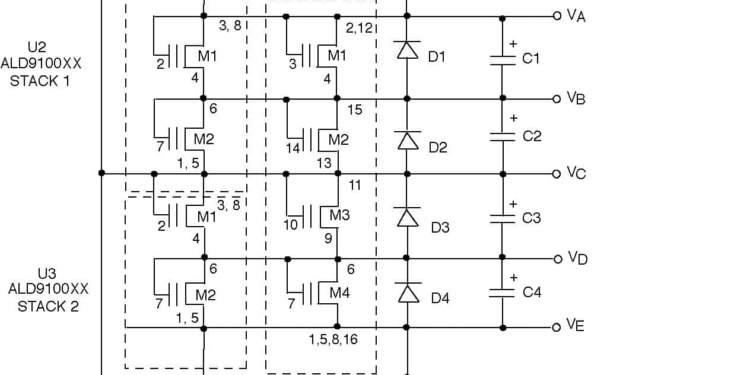source: Softei article
Advanced Linear Devices (ALD) has announced high-voltage supercapacitor balancing PCBs designed to automatically control leakage current and enhance reliability. The ALD SABMB810028 boards are designed for use in data centres, industrial automation, public utility, and transportation systems.
The ALD SABMB810028 boards are built with ALD810028SCLI SAB MOSFETs that provide balancing for 2.8, 3.0 and 3.3V supercapacitors arranged in a series stack by equalising the leakage current of each cell. ALD SAB MOSFET arrays used in each board provide industry’s most scalable, low-power solution. Additionally, the MOSFETS balance each cell through low levels of leakage current without exposure to supercapacitor charge/discharge voltage levels for cells of 3000 Farad (F) or more.
Higher voltage supercapacitors are being introduced to address the energy storage needs of data centres and industrial automation. They need to be reliable to meet the demanding standards for back-up power systems, and ALD believes that these boards balance high voltage supercapacitors through a low-voltage, low leakage and low current controlling method in a small and scalable form factor.
The ALD SABMB810028 boards are rated for operation from -40 to +85 degree C and are available with ratings of 2.8V (one microA operating current), 3.0V (100-microA) and 3.3V (1,000-microA operating current).
In many cases, points out the company, the operating current is equivalent in magnitude to the leakage current of the supercapacitors.
Over-voltage is a leading cause of failures for supercapacitors. Design engineers need to balance all supercapacitor cells in a stack of two or more to combat over-voltage. When installed on the board, ALD’s SAB MOSFET(s) play a vital role in preventing over-voltage, and the boards enable system engineers to test, evaluate, prototype or enter production volume. ALD claims that its SAB MOSFET technology provides a superior circuit design to other passive or active balancing schemes with cost and design space options for supercapacitor leakage currents.
The SABMB810028 boards are scalable, allowing them to meet the growing application of multiple supercapacitor cells in modules and meet the energy storage needs of higher voltage systems. Engineers looking to meet the needs of new 700V systems, for example, could arrange 64 ALD SABMB810028 boards together to ensure safe voltage balancing.
The ALD SAB MOSFET boards allow supercapacitor cell charging and discharging currents to pass through the cells themselves directly, bypassing SAB MOSFETs mounted on the board with near zero additional leakage current. This, says ALD, is a superior alternative to other methods where additional power dissipation used by the circuitry far exceeds the supercapacitor energy burn caused by leakage currents.
The SABMB810028 board is designed as a plug-and-play PCB for supercapacitors of 0.1 to 3000F and beyond. The average additional power dissipation due to DC leakage of the supercapacitor is zero, which makes this method of supercapacitor balancing highly energy efficient, notes ALD, and well suited for low-loss energy harvesting and long-life battery operated applications.































